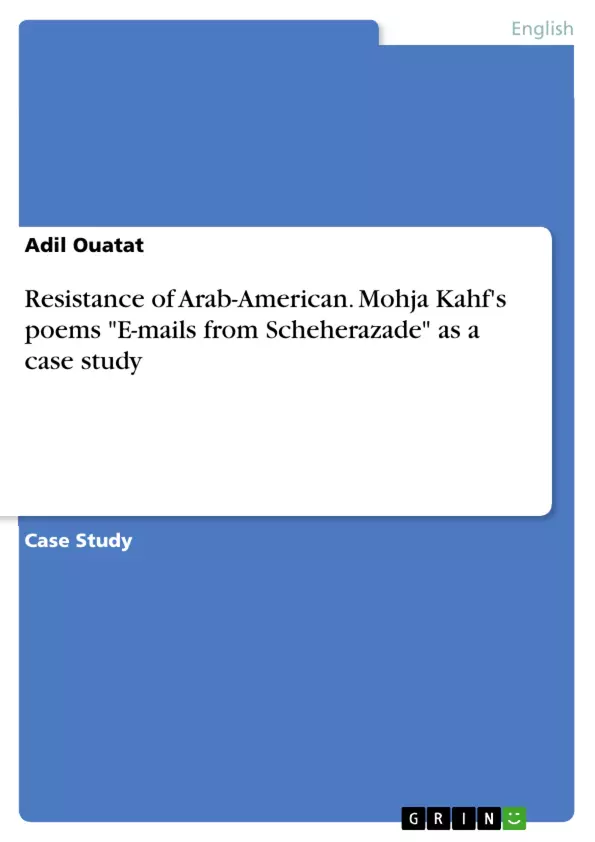This paper examines how the contemporary Arab-American poet Mohja Kahf challenges the western and patriarchal interpretations of some Islamic cultural symbols like "Hijab" (the veil). In poems like "Descent in JFK", "Hijab Scene # 7", and "Thawrah Des Odalisques at the Matisse Retrospective", Mohja Kahf offers an interesting counterpoint to challenge hegemonic narratives about Arab-American women rooted in the nineteenth century Orientalist discourse, and foregrounds the paradoxical experience of what it means to be a veiled Arab-American Muslim woman in a non-Muslim country. While this paper focuses on Kahf's use of poetry as a form of resistance, it also rethinks the contemporary history of Arab-American women's stereotypic repertoire.
Inhaltsverzeichnis (Table of Contents)
- Abstract
- Introduction
- Arab-American Women and the Orientalist Heritage
- Mohja Kahf: A Counterpoint to Hegemonic Narratives
- The Veil and the Western Gaze
- The Paradox of Identity
- Language as a Weapon
- Conclusion
Zielsetzung und Themenschwerpunkte (Objectives and Key Themes)
This paper aims to examine the work of contemporary Arab-American poet Mohja Kahf and analyze how she challenges Western and patriarchal interpretations of Islamic cultural symbols, particularly the hijab. The paper focuses on Kahf's use of poetry as a form of resistance against hegemonic narratives about Arab-American women, while also rethinking the history of Arab-American women's stereotypic representations.
- The portrayal of Arab-American women in Western culture
- The role of Orientalist discourse in shaping perceptions of Arab-American women
- The experience of being a veiled Arab-American Muslim woman in a non-Muslim country
- The use of poetry as a form of resistance against stereotypes and misrepresentations
- The complexities of hyphenated identity and the struggle for self-definition
Zusammenfassung der Kapitel (Chapter Summaries)
The introduction provides an overview of the paper's focus and main objectives. It highlights how Mohja Kahf, through her poetry, challenges dominant interpretations of Islamic cultural symbols, specifically the hijab.
The second chapter discusses the history of Arab-American women's representations through the lens of Orientalism, emphasizing the recurring portrayal of these women as silenced, oppressed, and timeless. The chapter cites instances where Kahf's identity as a veiled Muslim woman has been misconstrued and her artistic abilities questioned.
Chapter three explores the pressures faced by Arab/Muslim-American women both from within and outside their communities. It examines the impact of their dual identity and the challenges of reconciling their different cultural backgrounds.
The fourth chapter highlights the emergence of Arab-American feminist writers as a counterpoint to hegemonic narratives about Arabs and Arab-Americans. It focuses on Mohja Kahf's work and her unique approach to challenging American misconceptions about Arab-American women and their identity.
Chapter five delves into Kahf's use of the mythological figure Scheherazade in her poetry and explores how she employs her art form to resist and challenge Western interpretations of Arab women as oppressed. The chapter analyzes specific poems like "Descent into JFK" and "Hijab Scene #7," demonstrating how Kahf uses language to deconstruct stereotypes and reclaim her identity.
Schlüsselwörter (Keywords)
Key terms and concepts explored in this paper include Mohja Kahf, Arab-American women, hyphenated identity, Muslim feminism, Diasporic discourse, Orientalism, hijab, poetry as resistance, and the challenge of reconciling multiple identities within a complex cultural context.
- Quote paper
- Adil Ouatat (Author), 2023, Resistance of Arab-American. Mohja Kahf's poems "E-mails from Scheherazade" as a case study, Munich, GRIN Verlag, https://www.grin.com/document/1316453



